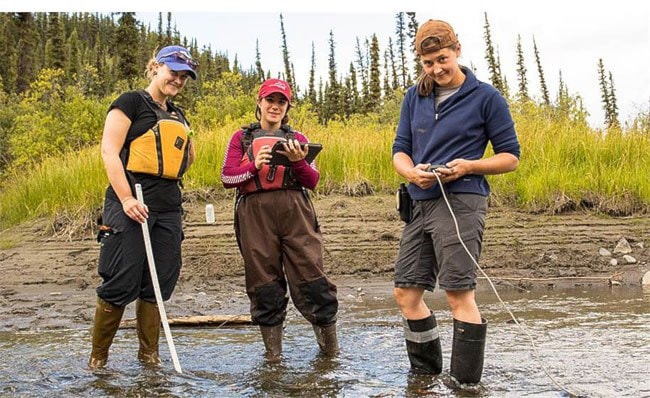Researchers have found that a new DNA technology is an effective tool for finding which Yukon waterways contain chinook salmon.
Their results show that environmental DNA, or eDNA, is 95 per cent accurate in detecting the presence of the fish.
Environmental DNA refers to the genetic material left behind by organisms in a body of water, including in mucus, urine and feces. It typically lasts in the water for about three weeks, and it can give scientists a record of what’s living in the water without actually having to find the animals themselves.
To figure out whether chinook salmon are living in a particular river, for instance, researchers just need to collect a single water sample and send it to a lab for analysis.
This technology has been proven elsewhere, and on other species. But this is the first time it’s been tested on chinook salmon in the Yukon.
Last summer, the Yukon Research Centre partnered with environmental consulting company Hemmera to collect water samples containing eDNA from 30 sites around the Teslin, Takhini and Nisutlin rivers and Kusawa Lake.
Chinook salmon were already known to live at most of those sites. The goal of this study, said project coordinator Kirstin Damude, was to show that eDNA could reliably confirm what scientists already know.
“The results were 94.9 per cent accurate in detecting true positives,” she said, meaning that chinook salmon DNA was found in almost every site where it was expected.
The salmon had not previously been found in Kusawa Lake, however. Damude said samples taken from the lake did not contain chinook DNA, which seems to support the idea that salmon travel up the Takhini River, but not right into the lake.
The researchers also tested the accuracy of the technology by taking samples from both sides of natural barriers in the water. As expected, chinook DNA was found below the barriers, but not above them where salmon cannot pass.
Aside from being the first eDNA test for Yukon’s chinook salmon, this experiment was unique in one other way.
“As we talked more and more to people who have used eDNA technology, we realized that this is the first test that has used eDNA in high-volume waterways,” Damude said.
The fact that the technique works in large rivers bodes well for the future of eDNA technology in the territory. Damude says it could be used to develop maps of chinook salmon in Yukon waterways.
But eDNA has limitations, too.
For one thing, it can only provide information about whether a species is present or absent. It can’t tell scientists or management officials anything about the size of the population.
It also doesn’t reveal anything about the fish, like their age, sex or which stock they belong to.
During a public session about the project last fall, Dennis Zimmermann, executive director of the Yukon Salmon Sub-Committee, had some doubts about the technology.
“I want to make sure it’s being used to solve a problem, as opposed to just creating more data,” he said at the time.
But Damude says it will be up to government and industry to come up with questions that eDNA can answer.
The water samples collected last summer were also tested for bull trout DNA, a species at risk in the Yukon.
Damude said none of the samples tested positive, but none of the sample waterways was known bull trout habitat.
She said the next step will be to test waterways that are known to contain bull trout, to test the accuracy of eDNA technology for that species.
Contact Maura Forrest at
maura.forrest@yukon-news.com
